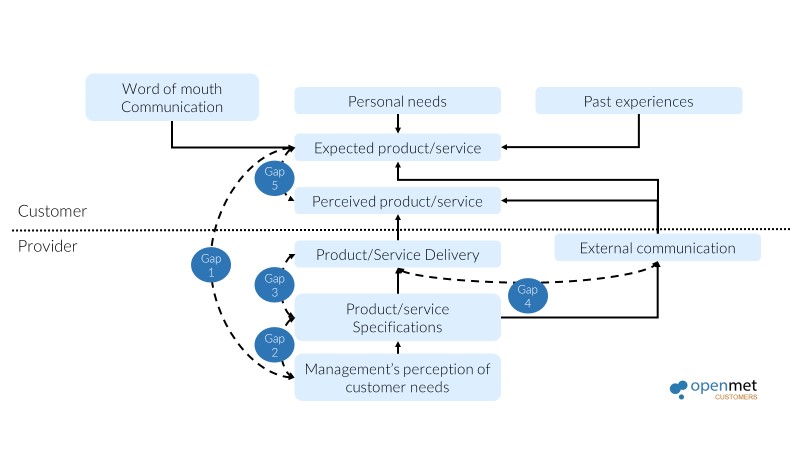Many studies assessing customer satisfaction follow the same pattern, which we can broadly sum up as having the following phases:
- Definition of the goal of the project and the indicators we want to assess
- Definition of the survey model and methodology to use for evaluating satisfaction
- Design, implementation of the survey and collection of data
- Analysis and interpretation of the results
- Identification of the critical aspects for improving customer satisfaction
- Design of the plan of action for improvement
Gap analysis
The last of these phases – the design of the plan of action – is especially important because, if properly formulated, its implementation will result in the desired improvement in customer satisfaction. However, defining the actions to take is no mean feat: we must relate the aspects we have identified as priorities for customer satisfaction to real and specific actions for improvement in the organization. It is not always easy to find this relationship between internal actions and improved customer satisfaction.
In this article, we will briefly explain gap analysis, one of our favorite tools when it comes to thinking up and creating Plans of Actions.
1. What is gap analysis in customer satisfaction?
Gap analysis is part of Servqual, a very popular methodology for evaluating and managing service quality. Specifically, gap analysis is an analytical tool proposed by Servqual to find out why customers experience low quality services.
Although gap analysis was initially limited to the identification and management of service quality, it is an ideal tool for the management of customer satisfaction. Customer satisfaction is a broader concept that includes service quality and other aspects related to customer satisfaction with physical products and extended/expanded products (in the marketing sense). At Openmet, we use gap analysis to find out the causes of customer dissatisfaction.
2. How does the gap analysis process work?
Essentially, gap analysis is a tool for reflection that:
- Asks us about past causes of customer dissatisfaction
- Leads us to possible answers
In its classic version, gap analysis models customer dissatisfaction through five possible gaps, as shown in the figure:
Each gap is a possible cause of dissatisfaction:
- Gap 1: Difference between Customer Expectations and Perceptions of needs by Management. Occurs when the company management does not understand what customers really want.
- Gap 2: Difference between Perception of needs by Management and Specification of the service. Occurs when Management understand what customers want but this does not translate into correct specifications and orders to the rest of the company.
- Gap 3: Difference between Specification of the service and the Service produced. Occurs when the people who “produce” the service are unable, unwilling or do not know how to reach the specified standard.
- Gap 4: Difference between the Service produced and Communication. Occurs when the service expectations formed by customers based on corporate communication are not met.
- Gap 5: There is no clear consensus on what this gap means. Initially, it meant the difference between Expectations and Perception of service, which may arise when the customer sees a characteristic of service quality as something undesirable. But this gap is also now used to identify overall customer dissatisfaction, which appears as the result of the sum of the other gaps. At Openmet, we prefer the first of the two versions because it adds to the analysis of the causes of dissatisfaction.
- Over time, other possible gaps have been added (6 and 7) concerning possible errors in the perception that company employees have of customer expectations.
When a customer satisfaction study identifies a particular problem (for example, dissatisfaction with customer service at the call center), gap analysis can help us to explore the causes of this problem by asking the following questions:
- Is this a “Gap 1” problem? Continuing with the call center example, this could happen if the company management fails to understand the importance and level of response expected by customers from the call center and does not therefore implement a good solution because of this lack of understanding. In this case, a good plan of action to solve the problem could be to invest in a good marketing department, market research or in increasing customer contact and orientation among employees.
- Is it “Gap 2”? This would occur if the company management properly understood the customer service needs but failed to implement the specifications correctly in order to provide the desired level of customer service. If this were the case, a possible plan of action to solve the problem would be to systematize the specifications (e.g. through ISO/EFQM). Another possible plan of action would be the implementation, use and monitoring by Management of indicators directly related to capacity and satisfaction with the call center.
- … And so on and so forth with all the gaps.
In the end, what we achieve with this exercise of questions, answers and potential plans of action is a joint reflection with the company management on the reasons for the dissatisfaction and the best plan of action to adopt to solve them.
In our day-to-day work, we have found gap analysis to be a very useful and essential tool for the true “management” of satisfaction. It ensures that the study and survey of customer satisfaction are not relegated to the back burner but actually generate effective and relevant change in the company, helping it to improve customer satisfaction and progress towards excellence.
Conclusion
We have found gap analysis to be a very useful tool for understanding and discussing the root causes of customer dissatisfaction and providing guidance as to the plan of action required to improve customer satisfaction.
More information on Customer Satisfaction.






2 thoughts on “Gap Analysis for Customer Satisfaction”
Comments are closed.